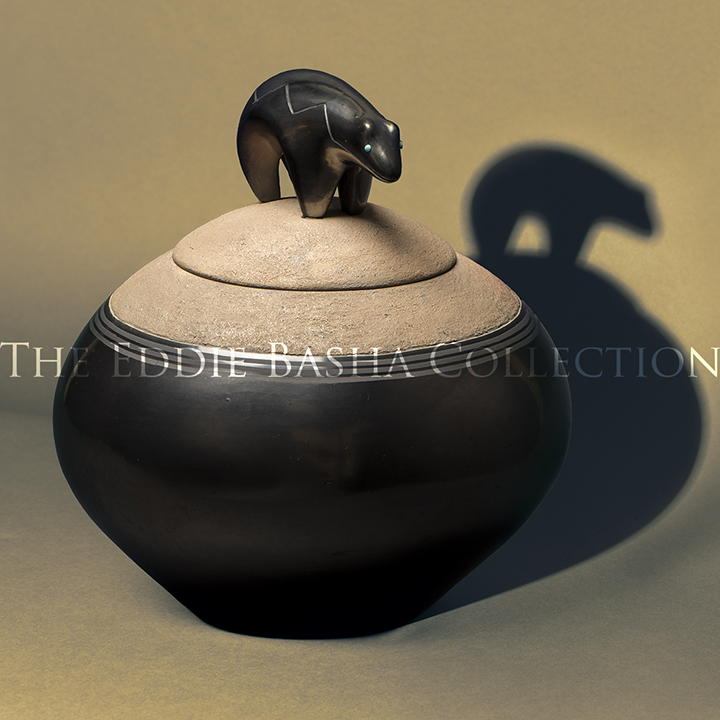Tony Da
(b. 1940)
Tony (Anthony Edward) Da descended from a most talented family of potters at San Ildefonso Pueblo. His father, Popovi Da, was one of the first pueblo potters to break with tradition and create something other than black-on-black pottery. Likewise, his grandparents, Maria and Julian Martinez, were even more ahead of their time when, in the early 1900s, they broke with tradition when they created the now-famous black-on-black pottery, breaking away at that time from the polychrome wares that were traditional. With such a talented family, Tony was destined to be talented and famous, and certainly he was.
Maria and Julian were the first to transform everyday utilitarian pottery into non-functional works-of-art pottery when they fully developed the black-on-black wares around 1925. Following his father’s (Julian) death in 1943, Popovi Da began assisting Maria, and by the 1950s he began infusing his own ideas into pottery making. Popovi began painting magnificent polychrome pieces reminiscent of his father’s early works. Then he began to experiment with inlaying turquoise into pottery. It was this technique that Tony picked up on and eventually perfected.
Tony was born in 1940 and in his early student years experimented in jewelry making and painting. Following a stint in the U.S. Navy, he returned to San Ildefonso in 1964, was fascinated with what Maria and Popovi were doing, and apprenticed himself to his grandmother.
Tony drew easily but selectively on his experience with both painting and jewelry. Early on, he worked in the two-tone black-and-sienna style, which Popovi Da introduced. He moved rapidly into the setting of turquoise into some of his wares, such as lidded vessels, bear fetishes, and sculptures of turtles. Indeed, Tony was the first pueblo potter to make extensive use of turquoise inlay in pottery. He next produced magical combinations of clay and wrought silver, as well as pottery inlaid with shell beads (hieshe). Tony’s work is immediately recognizable, and viewers have compared his more complex pieces to such objects as Middle Eastern jewelry boxes and Byzantine reliquaries.
“Tony soon excelled as one of the pace-setting pioneers in incising designs into potterysurfaces, combining delicately etched images with inlay and red, sienna, or two-tone finishes to create works with wholly novel effects. A favorite incised motif was the avanyu, the plumed water serpent associated in pueblo lore with summer rains. In other pieces he used a buffalo with heartline, or motifs inspired by the prehistoric Mimbres culture, including the feather motif popularized by his grandfather. As a measure of his rapid progress, in 1967, just three years after beginning his apprenticeship with Maria, Tony’s works appeared with his grandmother’s and father’s in the definitive “Three-Generation Show,” an exhibition honoring the pottery art of the Martinez-Da families at the U.S. Department of the Interior in Washington, D.C.
Ever since, Tony Da’s inspired, innovative body of work has exerted an enormous impact on the look of pueblo ceramics. An artist of conspicuous ability and clear vision, he came upon an art scene very much in flux—thanks, in large part, to the efforts of his own family. Tony built something new upon the foundation provided by his predecessors. Tony was one of those rare figures who rise up from the artistic continuum, a gifted innovator whose work signaled significant changes in the mainstream of pueblo ceramics. When such contributions find favor, as his did right away, they work their way into the accepted vocabulary of the art form and within a generation come to be thought of as ‘traditional.’”
The Martinez-Da family was fraught with tragedy, especially on the male side. Julian Martinez died prematurely in 1943, at the age of 46 years. He was at the peak of his career. Popovi Da, likewise, died early, in 1971, at the youthful age of 48 years. Tony’s career ended abruptly on Friday, April 15, 1982*, at the age of about 42 years, as the result of an off-road motorcycle accident that precluded his return to pottery making (he did continue painting). With the wonderful artistic creation left to us by these remarkable men, one must wonder what they would have gone on to do had they been able to create for another ten or twenty years.
Source: Adobe Gallery Art of the Southwest Indian
